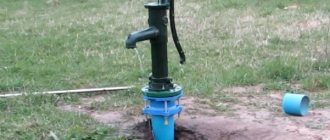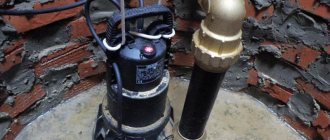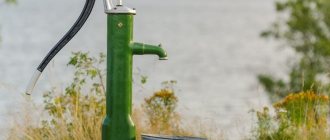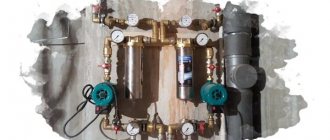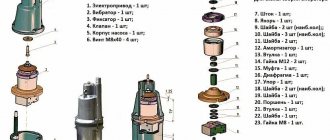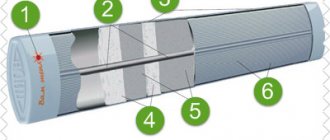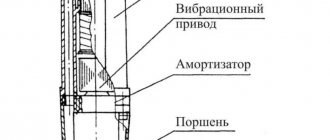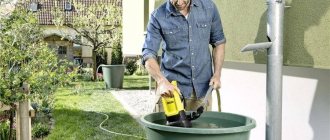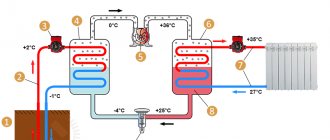A pump is a special device that, by imparting potential or kinetic energy to a liquid, moves it under pressure (suction or pumping).
The main parameters that are important for evaluating a pump:
- Q is the volume of liquid that the pump is capable of moving in a certain unit of time (volume flow);
- N is power consumption;
- H - efficiency (efficiency factor);
- p is the pressure that develops during work;
- H is the pressure that corresponds to a specific pressure.
In other words, a pump is a device that converts the energy created by a motor or human power into the energy of the flow of the fluid itself. It can also be used to move gas flows or mixtures, suspensions, colloidal substances. The driving force is the resulting pressure difference.
Classification of positive displacement pumps
Displacement pumps are also divided into groups according to their characteristics.
Pumps are classified according to:
- putting the pump into action;
- depending on the official purpose;
- type of action;
- piston designs;
- type of drive;
- cylinder location;
- the type of liquid being pumped;
- piston speed.
In industry, as well as in private households, submersible, semi-submersible and surface pumps are most widely used.
Selecting a water pump
For private use, consumers prefer to purchase small pumps or pumping stations that can provide their home and property with water as efficiently as possible.
The choice of pump should be based on a number of parameters, each of which has its own meaning.
- The depth of the well that the pump will encounter. Depending on the depth of the mine, as well as the distance of the housing from the source of liquid, the type of pump is selected, as well as its power.
- Water level. Can be static and dynamic. Static - the water level that is constantly in the source at a time when there is no pumping of water. Dynamic - corresponds to the distance from the surface of the water surface to the ground during active pump operation
Thermal insulation of external water supply
The location of the pipes below the freezing level of the ground allows you to avoid measures to insulate the main line. However, not all areas can boast a sufficiently low groundwater level, which completely eliminates the possibility of digging deep trenches. In this case, the solution to the problem is to lay pipes at a shallow depth and properly insulate the external water supply.
Relatively recently, the only way was to wrap external communication pipes with thermal insulation material and plastic film to protect them from water.
Modern methods, materials and technologies make the insulation process simpler and significantly increase the efficiency of heat conservation. Modern methods of insulation include enclosing pipes in a hard polystyrene foam shell at one of the production stages.
A heating cable stretched along the main and attached to the pipe is the most effective option for a water pipe with a diameter of 32 mm. However, this option has one significant drawback - the need to connect to the power supply network. This problem is not of particular importance for owners of suburban housing who constantly live off-grid. In case of a power outage, they have an alternative option - a generator running on gas, gasoline or diesel fuel.
It is recommended to perform independent installation and connection of a pumping station only if you have experience in installing, replacing or repairing pumping equipment. A simple home craftsman without the necessary knowledge and skills should resort to the help of a professional craftsman or, as a last resort, carry out the work under his supervision.
Submersible pumps
The submersible pump lowers itself below the level of the liquid it is pumping. This principle of operation ensures active cooling of the unit components, allows lifting liquids from great depths, and also pumping liquid with dissolved gas.
Installation is carried out in technological tanks, wells, boreholes.
Types of pumps:
- Rod In this type of pump, the motor is located on the surface of the liquid, and the connection is made through a rod (mechanical method).
- Rodless. They are a single unit with a hydraulic or electric motor. Power is supplied via a submersible power cable. Rodless pumps include well, borehole, drainage and sewage pumps.
An indicator of the quality and efficiency of a submersible pump is the duration of the period of stable operation with a high level of energy efficiency.
This parameter is called Pump Life Cycle Length (Pump LCL) in a Water Well. The length of the life cycle of a pump in a well affects the costs of repair and operation of the unit. Application of submersible pumps:
- irrigation systems;
- pumping liquefied hydrocarbon gases;
- oil production;
- mining of uranium, rare earth elements, gold;
- utilization of low potential geothermal energy;
- water supply and sewerage for industrial and municipal buildings, private houses;
- Pumps for pumping liquids from basements or swimming pools, private water supply.
Surface pumps
These pumps are used to increase the pressure in the home water supply system.
These units are mounted on the surface, without immersion in a source of liquid. Capable of pumping water from wells no more than 8 m deep. Advantages:
- ease of installation;
- small dimensions;
- possibility of easy installation without the involvement of specialists;
- stable operation in the presence of air pockets;
- high pressure water supply;
- high efficiency.
Flaws:
- high sensitivity to water purity;
- maximum working depth - approximately 9 m;
- using an ejector reduces system performance and reliability;
- high noise level;
- the need to fill the main with water.
Principle of operation
Operating principle: water is sucked in due to the fact that a vacuum is created at the end of the hose lowered into the water. The pressure difference arising in this case is equal to the atmospheric pressure (760 mm Hg).
The density of water is less than the density of mercury, making calculations it turns out that the working height of the pump pumping water will be 10.3 m. However, by introducing the length of the horizontal pipe into the calculations, the actual working height will be about 8 - 9 m.
When calculating the parameters for purchasing a pump, you need to take into account the distance of the source from the pump. The formula for calculations looks like this: Y = 4(8 - X).
Where:
- Y is the length of the horizontal part;
- X is the height of the liquid rise.
Surface pump design
Surface pumps are divided into groups, each of which uses different operating principles.
- Vortex. Compact and inexpensive units. Efficiency - about 45% (low). Used for irrigation or pumping water from basements. Reliability is not high; they are not recommended as a device for ensuring uninterrupted water supply.
- Centrifugal. Efficiency 92%. The pressure is high, which allows them to be used to supply water in pumping stations.
- Ejector. They work by applying the Bernoulli principle on two circuits: in the first circuit, liquid is supplied to the ejector nozzle, and due to the pressure difference, liquid is sucked from the external circuit. This principle allows you to lower the ejector to a depth and solve the issue of limiting the suction height. However, submersible devices are more often used to pump water from depth.
Important little things
Quite often, it is the most important details regarding the operating conditions of the equipment that are usually written in the instructions in the smallest print. And it is these little things that you should pay attention to when purchasing equipment and installing it.
As for both submerged and surface models, a check valve must be included in the general well layout scheme, which prevents the outflow of water from the pipeline. However, for submerged models, the malfunction of such an element or its absence when used with a rubber or plastic hose is not critical; during operation, water is still pushed out of the pump and then follows the hose. But for surface models, the presence of such equipment is extremely important; in addition, when periodically using a surface pump without a check valve at the end of the PVC pipe, you will have to constantly have 5-10 liters of water on hand to pour into the neck of the pump before each new start of the engine.
And of course, safety - submerged models have a high class of insulation, both of the cable and of the electrical equipment itself, which cannot be said about surface models with an open electric motor.
Semi-submersible pumps
A semi-submersible pump is a unit that can be used both in industry and at home.
The location of the working shaft determines their vertical design. The set of working elements for pumps of this type is not much different from others. There is an electric motor, a downpipe and a working element. The working body and the engine are spaced on opposite sides of a cylindrical body, which is partially immersed in liquid. This position ensures that the working element is in the liquid, and the electric motor is on the surface. The shaft is located inside the housing and transmits rotational motion to the working element from the electric motor. The output shaft and the working element are connected by a flexible coupling.
The working body can be a vortex or centrifugal wheel, a piston or an eccentric screw. The principle of operation of the pump - volumetric or dynamic - depends on what the working part of the device is.
Fastening is carried out using bolts with which the unit is screwed to the tank cover.
If small pumps are used, the mounting may be missing. Advantages:
- ability to work with liquids of varying degrees of contamination;
- the capability of the pump itself depends on the type of liquid;
- ease of operation.
Why Borey?
We produce industrial pumps of various capacities, which makes them accessible to both large and small companies.
Our equipment is fully adapted to work in Russian conditions.
We not only produce pumping units, but are also ready to offer spare parts and components for similar models. In addition, you can rent a motor pump if we are talking about single contract work. Our specialists are ready to select the necessary pump for any task of draining a site or draining groundwater.
Comparative characteristics
The table shows the comparative characteristics of submersible, semi-submersible and surface pumps.
| Submersible pump | Semi-submersible pump | Surface pump | |
| Reliability | Not tall. The motor as well as the mechanical seals experience chemical wear. As a result, liquid may enter the motor. | High. The motor, as well as the mechanical seals, do not come into contact with the liquid. There is no danger of liquid getting into the motor. | Average. It is necessary to check the motor and all components before starting the engine. |
| Maintainability | Low. In case of breakdowns, you must wait for special spare parts, since the design of the motor and seals are specific. Repair requires removing the pump from the liquid or container, which increases time costs. | High. In case of breakdowns, dismantling the device is not required. Domestic parts and mechanical seals are suitable for repairs. | High. In case of breakdowns, dismantling the device is not required. Domestic parts and mechanical seals are suitable for repairs. |
| Mobility | Possibility of quick movement, self-assembly, installation on almost any surface. | Fastenings for installation are required, as well as special lifting mechanisms, without which installation becomes much more complicated. | Easily mounted on a movable frame or light trolley. |
| Price | As a result of using a submersible pump motor, the cost is 1.5 to 3 times higher than other units. | Relatively low cost. | Relatively low cost. |
| Temperature of the pumped liquid | The engine is cooled, which limits the temperature to + 90 degrees. | The pump is capable of pumping liquid with temperatures above + 450 degrees. This is due to the fact that the engine is located outside the liquid. | The motor is not immersed in liquid, but the temperature of the pumped material is no more than 260 degrees. |
| Easy to install | High simplicity. Does not require special devices, you can install it yourself. | Average. Special mounting brackets are required. Work is underway to secure the pump to the tank cover with special bolts. | High simplicity. Does not require special devices, you can install it yourself. |
| Suction/immersion depth | Not limited | Up to 6 m. Longer pumps are made to order. | Up to 8 meters. If the length of the pipe in the horizontal part is long or the pump is far from the source, the length is reduced. |
| Created pressure | Up to 100 m - with a single-stage pump, up to 3,000 m - with a multi-stage pump. | Up to 160 m - single-stage, up to 2,000 m - multi-stage. | Up to 77 m maximum. |
| Pump delivery | No more than 7000 m3/h. | No more than 90,000 m3/h. | No more than 1200 m3/h. |
The difference between semi-submersible and submersible, as can be concluded, is not too big. The difference in the installation principle is significant in the case when it is necessary to pump liquid from a greater depth, which a semi-submersible pump cannot handle. And when choosing whether to purchase a surface or submersible pump, you need to take into account all the parameters of the liquid and the well.
How do the devices differ?
The distinctive features of pumping stations for a dacha or country house are their unique compactness, quick installation, as well as simple maintenance and an acceptable cost for all segments of the population. A supply of water accumulates in the hydraulic tank, which allows the product to be turned on and off less frequently, resulting in an increase in its service life.
The pump is installed inside a hydraulic structure under water, and the pumping station for the well is mounted in the basement of the house or in a specially built caisson, which is insulated during cold weather.
Attention! If the water intake level does not fall below 8 meters, then it is better to choose a pumping station.
Popular models of pumps of different types
Submersible pump models
Well pump from Aquario, model “Aquario ASP1С-70-90”.
The pump diameter is 90 mm, the maximum vertical operating pressure is 74 m. The operating power is 900 W. Productivity is 55 l/min. Cord length - 45 m.
Pump type: centrifugal.
Device: multistage pump, floating impellers, electric motor, capacitor. The capacitor is built-in, the motor type is washed.
Purpose: supplying water from a well, a well, an open reservoir.
It is used for watering garden plots and supplying water to the house. Characteristics:
- rotational movements reproduced by the pump provide high efficiency;
- noise level is low;
- the working system of the unit is durable, since there is no fragile and wear-out valve-piston ligament;
- do not have a harmful effect on the water supply system and well.
Main advantage: noiselessness. The installation of this pump provides high-speed water supply from great depths with a low noise level that does not disturb the residents of the house.
Fecal pump, model Oasis FS-110R with cutting mechanism.
Pump type - fecal. The maximum number of starts per hour is 20. Liquid lifting height is 11 m, voltage is 220 V, frequency is 50 Hz.
The electric motor is single-phase, with a squirrel-cage rotor, single-phase.
Power 1.1 kW, flow 24 m3/h.
The pump is equipped with a blade for grinding particles. The maximum diameter of passing particles is 50 mm. The diameter of the inlet pipe is 2".
The unit is effective for pumping heavily contaminated water containing large particles. A special cutting blade crushes elements that fall into the water.
Design: electric motor, pump part, housing, float switch.
Automatic shutdown of the pump motor is carried out using a stator with a thermal projector. Shutdown occurs when the temperature of the windings exceeds the permissible norm.
The pump is recommended for country houses and summer cottages.
Surface Pump Models
Surface pump manufactured by Unipump, model AUTO JS 60-5.
Maximum vertical head - 33 m, power - 450 W.
Capacity - 50 l/min.
A 5 liter hydraulic accumulator is available.
Maximum suction depth - 8 m.
Water temperature - from 1°C to 35°C, pumped liquid - only clean.
Vertical installation of a pump with a centrifugal mechanism.
A Chinese-made pump consists of an electric motor, a hydraulic accumulator, a pressure switch (automation unit), a pressure gauge, a cable with a plug and a hose.
The hydraulic accumulator is equipped with a membrane made of food grade rubber.
Operating principle: the water supply network is under pressure. As a result of a drop in pressure in the system after opening the tap, the system will automatically start the pump based on a signal from the pressure switch. After closing the tap, the pump continues to operate until pressure reaches 3 atm, after which the device turns off.
Before installing the pump, you must ensure the quality of the water. If the liquid is heavily contaminated, this model is not recommended for installation. Installation is permissible only after the use of treatment or filtration stations. Installation of the unit is carried out according to the operating instructions.
Pumping station from the surface company Khozyain, model Khozyain NS-1000.
The pump comes with a 1 year warranty.
Maximum immersion depth is 8 m.
The maximum vertical working head is 45 m at a power of 1000 W.
Productivity - 70 l/min.
The permissible maximum liquid temperature is from 1°C to 35°C.
The pump, equipped with a built-in ejector, must be installed horizontally.
The diameter of the outlet is 1″.
The presence of solid particles no more than 1 mm is allowed. The type of pumped water is clean.
The pump is used to pump clean water with a minimum amount of impurities.
The unit is intended for home use in water supply and irrigation systems. The total amount of mechanical impurities should not exceed 100 g/m3.
